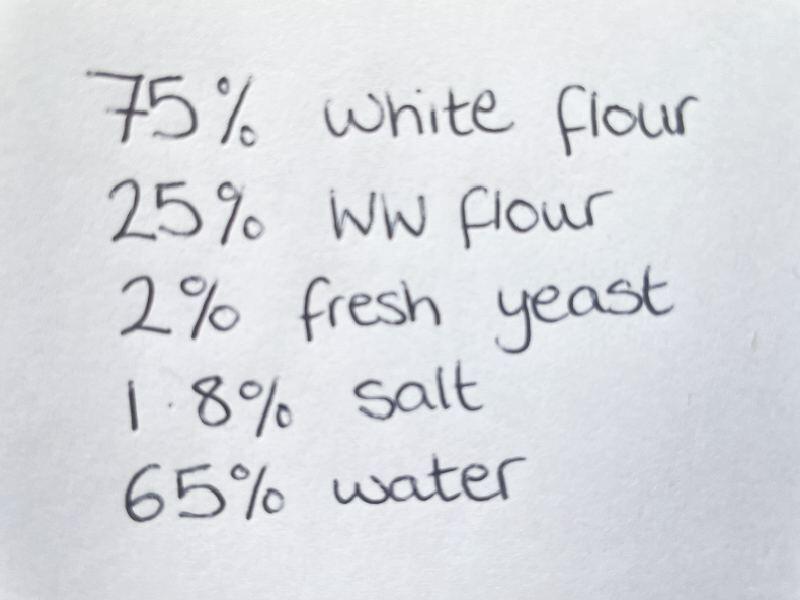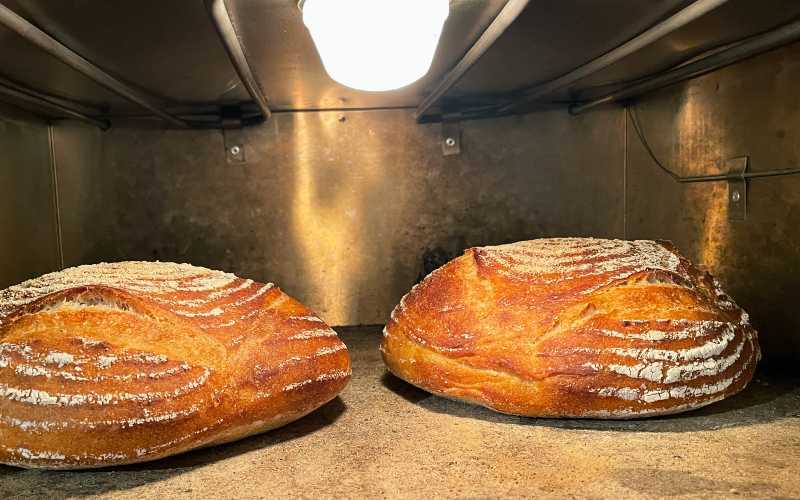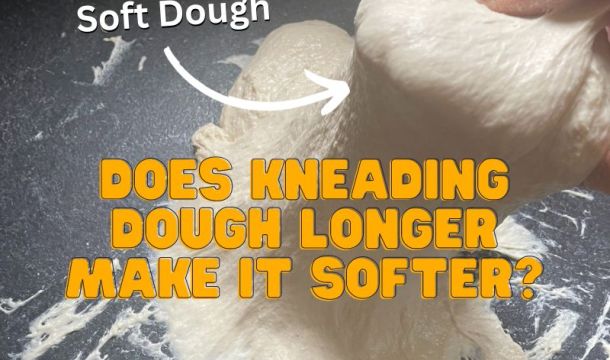
Making Bread In Bulk – How To Make Big Batches Of Dough

Many of you are looking to increase the batch sizes of your dough, so I thought I’d write a full guide on making bread in bulk. You can make big batches of bread to sell, give to friends or stockpile in the freezer. Either way, this guide will help you to make more bread and create a routine so that you can make several types of bread in one morning.
Here are 5 steps to making big batches of bread:
1. Plan your bake for the equipment you have
The amount and types of bread that you can make are reliant on the proofing device (banneton/bread tin etc.) that you use and the amount of space in the oven. You should also consider space and how confident you are to divide and shape large quantities of dough.
When preparing a large batch of bread, you may wish to ferment the dough in the fridge. This can be done by taking the proofing loaves out of refrigeration at intervals so they are not already at the same time. You don’t want eight loaves ready to bake when only two fit in the oven!
Overnight proofing is dependent on the amount of space available in the fridge and the number of proofing baskets or loaf pans that you have.
A big oven makes things much easier, but I get that many of you reading this have a home set up.
The important point is to know how many loaves you are comfortable proofing and baking at once. If you need to get some more baking tins or bannetons, get them ordered now!
2. Know when to divide the dough
When it comes to dividing a batch of dough, this should be done at the end of bulk fermentation. At this point, you will need to know your target dough weight and divide your dough pieces to match it.
You’ll need equipment to do so. The standard practice uses a metal dough scraper and a decent set of scales. Here’s the set I use at home:
A set of scales like these make it easy to work with the dough as the LCD is obstructed, the weighing pan is relatively large, and it won’t fly across the table like many ordinary kitchen scales!
3. Know what weight to divide your dough pieces
A small loaf is generally 500 grams, a boule for a 9-inch banneton is 650 grams, and a large 2lb loaf, similar to my basic bread recipe, is 950 grams. Full-length baguettes are usually 550 grams, but this is too large to fit inside a domestic oven, so when making baguettes at home, scale them at 250-350 grams.
Do your own research to determine what dough weight fits your proofing basket or bread tin.
How to divide a batch of dough
4. Plan your recipes
Many bakeries make fewer batches of dough than you might think. A sweet dough can be divided to make different types of bread. One portion of the dough may have fruit added, whilst the other portion can be used for doughnuts, Vienna rolls, or something else! This method can also be replicated for the inclusion of seeds, olives, or nuts in plain doughs.
If you are to prepare several doughs with similar ingredients, amalgamating your batches to make fewer batches is a sensible option. There will be less individualism, but by handling each dough differently during bulk fermentation and shaping, you’ll be able to create some special products.
Preferments vs bulk fermentation
As you scale up bread recipes, you will find that space becomes a problem. If you make large batches, you may need to purchase large containers to store the dough. But before you go out to your nearest catering store, there is another solution…
Instead of bulk fermenting an entire batch of dough, preferment 20-40% of the flour overnight. The fermented flour is added to the rest of the flour and the remaining ingredients for mixing.
The fermented flour speeds up gluten development time and increases dough maturity, this reduces the time of the first and second rises.
The amount of storage space required is less, so you won’t need as many large containers or space to make several batches.
5. Use a baker’s formula
To scale up a recipe, first, you’ll need to convert the recipe into a baker’s formula.
The baker’s formula of a recipe is where the ingredients are given as a percentage of the flour.
To convert an existing recipe to bakers percentages:
Ensure all measurements are in grams
Open a notepad (a spreadsheet makes things easier)

Take the total amount of flour used to be 100% – if using more than one flour. The multiple amounts should be combined to make 100%

Calculate the percentage of each ingredient against the flour

You have now converted your recipe into a baker’s formula

To use a baker’s formula to make a bread recipe, you’ll start with the total amount of flour you will use.
Then multiply the percentage of each ingredient by the total flour weight.
6. Determine how big your batch should be
You need to know the weight of your intended dough pieces and the number of loaves you are going to make of each. These numbers must then be multiplied to provide the intended batch weight.
For 3 large loaves at 950 grams: 3 x 950 = 2850 For 2 small loaves at 485 grams: 2 x 485 = 970
Add them together:
2850 + 970 = 3820
So we need 3820 grams of dough to complete our batch.
Next, see the amount of dough that 1000 grams of flour would give us in this recipe.
1000 (total flour weight) x 2% = 20 x 1.8% = 18 x 650% = 650 1000 + 20 + 18 + 650 = 1688
So 1000 grams of flour will provide 1688 grams of dough. To calculate how big our batch needs to be, let’s divide the intended batch size by the amount of dough 1000 grams of flour provides.
3820 / 1688 = 2.26
We now know the recipe for 1000 grams of flour needs to be 2.26 times bigger. But, for the sake of a little bit of dough being lost in production and easier numbers, I’ll round this figure to 2.3.
This means our total flour weight to make our batch should be 2300.
To create our recipe, we need:
100% flour @ 2300 grams x 75% = 1725 grams - White flour x 25% = 575 grams - Whole wheat flour x 2% = 46 grams - Salt x 1.8% = 41 grams - Yeast x 65% = 1495 grams - Water Total dough weight = 3882 grams Dough required = 3820 grams Waste = 62 grams
If you are using preferments or sourdough, the baker’s percentage gets a little more complicated. See the baker’s percentages article for more information. A spreadsheet makes the process much faster!
7. Prepare your baking routine

Once you’ve decided on the recipes, batch sizes and got all your ingredients together, it’s time to plan your baking schedule.
The object of planning is to avoid:
- Bottlenecking at the oven (everything ready at the same time)
- Multiple doughs requiring your attention at the same time
- Large waits between bakes will lead to an empty oven costing money to run
- Wasting time standing around and waiting
To do this, plan your recipes backwards:
Starting with the bread you’ll take out of the oven last, work backwards and plan each step of the recipe and what time it should happen. Of course, timings might be wrong the first time you use your schedule, but as you get closer to your recipes, it will improve!
Achieving the correct desired dough temperature and a consistent proofing temperature will help you to develop a winning routine.
Check out my DIY proofing box guide to learn how I control the temperature when proofing!
8. Prepare the baking area
Know where you’ll be undertaking each stage of the baking process before you get started. This makes your bake much less stressful!
Work out where you’ll be weighing your ingredients and dough, dividing the dough into pieces, and a proofing area.
A designated area for cooling is often overlooked, so have an idea of where your bread will go when it comes out of the oven and put some cooling racks up.
9. Storage and delivery
The last thing to think about when making bigger batches of bread is what you will do with it all!
There’s nothing worse than seeing your beautiful creations wilting away on the counter.
If you are going to give away or sell your bread, how are you going to transport and package it? These can be paper bags, plastic bags, cloths, or crates to be delivered loose.
If you are making a large batch to save making bread every day, how are you going to store your bread?
It’s often a good idea to store some loaves in the freezer. When you just don’t have the time to make one fresh, it’s handy to be able to grab one to thaw!
Making bread in bulk quickly
Instead of slowly fermenting all of your bread, you might want to make some quick bread recipes. These can supplement your range, or perhaps your customers might prefer them! I provide more information about these recipes and how to make dough rise faster in the linked article.
Making bread in bulk – Conclusion
These are my tips on making bread in bulk! I hope you found it helpful reading? If there are any tips you can add to this topic, please leave them in the comments below to help others. Ask questions there too! If you want to start a new bakery or micro-bakery, consider reading; is a bakery business profitable?
Frequently asked questions about making bread in bulk
If you’ve enjoyed this article and wish to treat me to a coffee, you can by following the link below – Thanks x

Hi, I’m Gareth Busby, a baking coach, senior baker and bread-baking fanatic! My aim is to use science, techniques and 15 years of baking experience to make you a better baker.
Table of Contents
- 1. Plan your bake for the equipment you have
- 2. Know when to divide the dough
- 3. Know what weight to divide your dough pieces
- 4. Plan your recipes
- 5. Use a baker’s formula
- 6. Determine how big your batch should be
- 7. Prepare your baking routine
- 8. Prepare the baking area
- 9. Storage and delivery
- Making bread in bulk quickly
- Making bread in bulk – Conclusion
- Frequently asked questions about making bread in bulk
Related Recipes
Related Articles
Latest Articles
Baking Categories
Disclaimer
Address
53 Greystone Avenue
Worthing
West Sussex
BN13 1LR
UK







